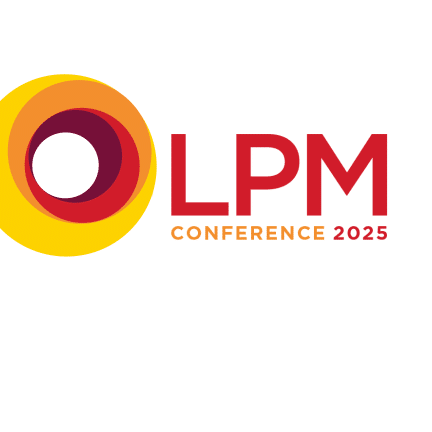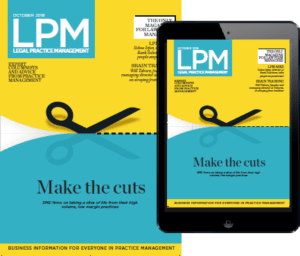
How business habits impact the effectiveness of your law firm
The effectiveness of your law firm is intrinsically linked to the daily habits of your team, says Chris Pucci, CEO of Osprey Approach.
Every law firm will have a combination of business habits that either help them to run a successful firm aligned with their goals, or habits that are hindering success and damaging performance.
Regardless of your goals, running a successful firm involves mastering the basics and adopting processes that help you to remain competitive. Improving the effectiveness of your firm requires breaking down your current processes and identifying areas of improvement that enable you to align with your goals, so that you can build effective habits.
Build better habits
Building good business habits helps you to establish a foundation of seamless and effective processes designed for maximum output. These habits, especially when combined across all individuals in your team, have huge benefits for your firm across compliance, client satisfaction, employee motivation, profitability, and much more. They provide a foundation that enables your firm to continue to optimise, stay flexible, and adapt to change.
Similarly though, continuing with inefficient habits will create cumulatively bigger challenges in time. If you find your firm has poor results or outcomes today, it’s likely due to a sum of small choices over a long period of time that eventually led to the problem. To avoid challenges in the future, you need to set yourself up for success today.
Long-term success
Long-term success requires an environment that enables effective habits to flourish while reducing inefficient ones. To help achieve this, you need four things – aligned goals, accountability, effective tools, and the right mindset.
Aligned goals
Aligned goals help you to focus on what is it you want to achieve. If you know your goals and your purpose, you’ll be able to design the most effective processes for the job, monitor performance, and communicate the plan to your team for firm-wide support.
Accountability
If your firm or team aren’t held accountable for their daily responsibilities, they’ll never be motivated to complete the necessary tasks. It can be easy to slip back into old habits, but with specific targets, individuals or teams are held accountable for adopting new processes to meet the wider goals. Performance can be monitored, and areas of improvement can easily be identified for continued development.
Effective tools
Do you have the right technology, infrastructure, digital tools, and people skills to achieve what you’re aiming for? Can you utilise the resources you already have, or does it require investment for long-term success?
The right mindset
As the saying goes, you’re only as strong as your weakest member, so ensuring your team has the right mindset for improvement, change and optimisation, is crucial to building the right environment for success.
How to create the right environment for better business habits
To help improve the effectiveness of your firm, there are five pillars that will help you set up the right environment – enabling you to reduce waste and implement effective processes: –
- Improvement by subtraction – focus on doing less of what doesn’t work, rather than concentrating on what does
- Make it easy – adopt new habits that your team can easily get on board with
- Foster the right mindset – adopt an open mindset of experimentation rather than one focused on outcome
- Tech adoption – give your team easy-to-adopt digital tools that enable them to be more productive, accurate, and effective
- Monitor performance – identify ways you can quantify the results of new habits right across the firm.
Further help and guidance on creating the right environment to foster good business habits can be found in Osprey’s guide to improving the effectiveness of your law firm.

Maximise success by implementing a continuous improvement mindset
Small, incremental and manageable improvements can add up to big advantages for a law firm, according to Chris Pucci, CEO of Osprey Approach.
In the world of business, and law, there are always so many changeable parts to juggle. Nothing stands still for too long, which is why – to be most effective and optimise for success – the habits and processes you build for your business need to be continually reviewed and improved.
Continuous improvement entails more than its label – it’s about identifying what is no longer serving the business well. Often, it’s the bad habits that are more detrimental to performance than following good ones. Being complacent could result in a range of risks – such as cyberattacks, faltering financial performance, disengaged employees, and poorer reviews from clients.
What is a continuous improvement mindset?
A continuous improvement mindset is a business culture that looks to enhance all elements of a business, including its processes, tools, services, and products. The focus, primarily, is that those improvements are small and incremental, implemented through frequent steps to achieve marginal gains rather than attempting large, complex, and resource-heavy projects.
It entails looking for small steps that take you closer to your goals helps with momentum and provide a sense of achievement and progression, which is essential for a sustainable plan and long-term motivation. That’s why a continuous mindset is based on goals without an end-goal, because this promotes curiosity and enables the team to always strive for better. The openness and willingness for change needs to be a culture adopted by frontline employees and management to see true impact.
A prime example of the impact of continuous improvements is the experience of the British Cycling team. You can discover more in our guide to maximising a return on your investment, which explains how David Brailsford, the team’s performance director at the time, looked for marginal gains that would compound and have a big impact. He famously said to forget about perfection but focus on progression, because that’s what would make the biggest difference.
Benefits of continuous improvement
A continuous review mindset puts your firm in the best position to achieve its goals, remain competitive, and tackle challenges. It allows the practice to be more agile and adaptable and ensures the foundations and basics of the business are performing at their best.
The compound effect of small improvements is a big impact on overall success, with minimum disruption and firm-wide responsibility. Benefits include:
- A positive impact to the bottom-line. Because when time is saved, costs are reduced, and return on investments are maximised, so profitability increases.
- An enhanced client service. Efficiencies are passed through to clients, which improves satisfaction rates. When employees are freed up to dedicate more time to the client experience it can boost retention rates, and reviews and recommendations increase to help win new business.
- An increase in business longevity. Reputations are improved through happy employees and clients, and risks and errors are reduced, which aid compliance and reduces costs. Plus, processes and tools are adaptable and flexible to meet unforeseen challenges effectively.
How tech can help
Running a successful law firm requires more than being an expert on the practice of law. In business, data is power, and a competitive firm will collect, analyse, and utilise the right information to make data-driven decisions that drive performance and potential.
Legal technology helps to digitalise and connect the data you hold to extract and analyse through reporting tools and business intelligence dashboards. This enables your firm to gain data-driven insight into performance, rather than relying on gut feeling or instinct. With a centralised practice and case management solution – which is integrated with your other business tools – you can build an accurate representation of your firm and make smarter business decisions based on fact, track trends, better allocate resource, and spot opportunities.
Without a connected digital platform, it’s an almost impossible task to collect and report on the data you hold. Management information gained from software can determine the priorities you focus on in your continuous improvement plans. This insight can help to identify the areas for improvement that will have the biggest impact on your goals and, crucially, it enables you to monitor the impact of your continuous review processes.
Status quo
Continuous review is already a requirement for compliance officers throughout the legal sector. The requirements set out by the Solicitors Regulation Authority for compliance officers for legal practice and compliance officers for finance and administration are there to ensure that the systems, tools, and processes in place to aid compliance are reviewed continually and the risk to the business is minimised.
Continuous training and development is also expected of all lawyers to ensure individuals are up to date with the latest legislative rules and best practices. That expectation of review should apply to business operations to ensure a firm is keeping up with client expectations, employee needs, and technology platforms.
A five-point continuous improvement plan
We’ve put together a five-point plan that sets out in detail the steps to consider when implementing a continuous improvement programme at your firm. The full user guide can be downloaded here, but briefly, the plan helps you to achieve the following:
- Create guidelines. Set some basic guidelines and structures to help employees understand the role they play in reaching your firm’s goals.
- Set goals and communicate. Look at the firm-wide, top-level aims and goals and ensure these are communicated to the entire team. This should not only consider your goals for the firm, but also the reasons why you’re implementing a continuous review plan.
- Map out current processes and challenges. This will enable real change to occur, while ensuring the team understands the current barriers and pain points. It will also help you to be more realistic when breaking down the improvement plan into manageable, actionable tasks.
- Define the ‘what’. Decide what can be improved to bring you one step closer to meeting your goals.
- Evaluate your digital tools. This enables you to assess whether you need to implement new tools or look at ways to optimise processes and maximise your team’s skills.
Future proof your law firm
By putting in place a continuous improvement plan, you’re giving your business every chance for success through boosted profits, happy staff and clients, a good reputation and high adaptability. By investing time to create solid foundations across all areas of your business – operations, talent, and technology – you’ll give your firm every chance of success.
It’s easy to become too focused on the need for perfection, but simply taking steps towards building better habits and having a continuous improvement mindset is a great place to start.
Most Popular

Where are the challenges for SME law firm leadership changing?

The leading annual picture of SME law firms' changing strategic priorities
TA Triumph-Adler provides tailored support to meet compliance requirements

Law firms undertaking identity verification checks must register as an ASCP

Robust onboarding processes are fundamental to effective risk prevention

Osprey Approach's webinar explores the benefits of a digital-first approach

How to deliver quality client service
The future of legal services lies in a better client experience, according to Osprey Approach’s CEO Chris Pucci – who presents ways for firms to deliver consistency and quality in service.
Legal software solutions are designed around features and functionality that streamline, enhance, and improve a firm’s performance. Fee earners are tasked with driving long-term efficiencies, increasing billable hours, and onboarding new clients, all to increase profits for the firm. This is why legal tech looks to reduce manual admin, increase productivity, and introduce automation in order to help fee earners maximise their time.
All too often, the most important part of a firm’s success is overlooked – the client. Increasing efficiencies to improve profitability is crucial for a firm’s success but without attracting and retaining clients, the longevity of your firm is at risk.
With practice and case management solutions (PCMS) increasingly becoming the norm – as firms realise that traditional, manual processes are costing them – it’s not the tech alone that will help you stand out from the crowd, but your client service. Quality client service will always be a key competitive advantage, so focusing your strategy on being client-focused will help you stand out above the crowd.
The importance of quality client service
Clients have high expectations of the legal services you provide, which is why it’s important that firms have the technology and processes in place to deliver a seamless, cost-effective, digital experience, to ensure you stay competitive.
Your average consumer does not have the qualifications or knowledge to understand the complexity of the legal services you provide. They will not know if you utilised every area of the law to win/progress their case, or whether another lawyer could have done a better job. But what they do understand is what quality customer service looks like and how a good client experience makes them feel, and that’s how they will measure and value the services you deliver.
In the case of law firms, and many other professional services, the benchmark for quality customer service is set incredibly high. Every day, your clients are tapping into exceptional, real-time consumer experiences from brands who are pushing the boundaries on what it means to be client centric. Market leaders like Amazon, Uber, and Deliveroo, are removing pain points for clients that they had previously learned to accept, therefore emphasising what it means to go above and beyond for your customer.
How to exceed client expectations
With expectations set so high, it can feel overwhelming for law firms to know how to implement the right strategies to improve client satisfaction. Often, this means that firms continue with the way things have always been done in a bid to get through the volume of work. But, with over 80% of respondents to the Legal Services Consumer Panel survey saying the reputation of a firm was the top factor considered when choosing a lawyer, offering quality customer service is now more important than ever to help you stay competitive. There’s a wealth of information on how to exceed client expectations in our guide, which can be downloaded here.
The best client-focused strategy that law firms can implement is simple – remove the friction and pain points from your clients’ experience. The reason why client-centric brands are loved worldwide is because they provide an easy and enjoyable customer service. They’ve removed pain points like delays and product usability issues, meaning customers want to return for the experience, which can often be prioritised above price.
This means firms need to identify and document all the ways their clients interact with them and review how easy the process is. Can you reduce or eliminate waiting times, increase the channels of communications, improve transparency or the simplicity of your service, or answer their questions sooner? Clients, above all, just want a stress-free and easy experience. And as most clients, when using your services, are in a period of change or in a vulnerable situation, it’s the little things that matter and those personal touches that help keep clients calm and feeling in control.
The digital tools you need to succeed
It’s impossible to keep on top of all the moving parts of a law firm manually, so taking advantage of digital tools and technology solutions – that help to streamline, automate, and modernise processes – is crucial for long-term success.
The fundamental features of PCMS help to streamline operations to increase efficiencies and productivity. These benefits are immediately passed on to your clients as they’ll experience a more accurate, timely, and confident service. But PCMS also help to further enhance your client experience, as well as your reputation, by providing the digital tools needed to offer a more modern digital experience. The software also reduces fee earners’ workloads, so more time is focused on the client’s needs instead of daily processes and manual admin.
The number one way your firm can deliver unrivalled client service is by offering a client web portal. This provides them with a secure, self-service platform that houses all case progression updates, documents, and data without the need for endless email chains, phone chases or visiting the office.
Other digital tools that help you to exceed client expectations are SMS text messages for immediate and easy communication, e-signature tools for hassle-free signing, and online questionnaires for easy data capture and client onboarding – all of which will help your firm to remove the common pain points that clients experience, while also keeping your internal processes efficient and profitable.
Future proof your firm with quality client service
The quality of your client service is always going to be the key decider in whether your firm is chosen over the competition and that is more important than ever as the bar continues to raise for the expectations of what is acceptable.
Law firms who embrace technology to manage the daily running of their business will be able to take advantage of the opportunities tech brings to enhance the client experience, including implementing a client portal, utilising e-signature tools, digitalising client onboarding, and speeding up communication.
For more help and advice about how you can exceed client expectations, as well as the tools you need to be successful, please download Osprey’s guide to providing quality client services here.
Most Popular

Where are the challenges for SME law firm leadership changing?

The leading annual picture of SME law firms' changing strategic priorities
TA Triumph-Adler provides tailored support to meet compliance requirements

Law firms undertaking identity verification checks must register as an ASCP

Robust onboarding processes are fundamental to effective risk prevention

Osprey Approach's webinar explores the benefits of a digital-first approach




